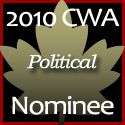 When Jim Prentice was given the Environment portfolio, it was not because he couldn't do any worse with it than Rhona Ambrose or John Baird, but because the Oil Sands were in trouble. Nations were beginning to refuse Alberta's 'dirty oil', and without Alberta's 'dirty oil', the Conservatives could not play 'dirty politics'.
When Jim Prentice was given the Environment portfolio, it was not because he couldn't do any worse with it than Rhona Ambrose or John Baird, but because the Oil Sands were in trouble. Nations were beginning to refuse Alberta's 'dirty oil', and without Alberta's 'dirty oil', the Conservatives could not play 'dirty politics'.Prentice defends oilsands following National Geographic article
Environment minister says it's 'just one article'
February 25, 2009
CBC News
Canada will continue to push the important role that Alberta's oilsands play in the North American marketplace, says Environment Minister Jim Prentice, despite a telling article appearing in March's National Geographic.
"It's very difficult to see the North American marketplace developing in an orderly way for energy without the oilsands being part of the equation," Prentice told CBC News on Wednesday.
The March issue of the National Geographic provides its estimated 40 million readers with a 20-page article that features pictures of sludge-covered tailing ponds and the sprawling oilfields.
Many of the pages show before-and-after pictures of the oilsands near Fort McMurray, Alta., while graphically describing how the oil is extracted — from the forest being cut down, to the peat, dirt and moss being removed, to the water stripping the bitumen from the sand, and the contaminated water flowing into tailings ponds.
The Alberta government has called the article "fair" and indicated that it appreciated that the author acknowledges the province's work on carbon emissions.
The article indicates that by 2020, Alberta carbon emissions will level off and by 2050, they'll decline to 15 per cent below their 2005 levels.
"Alberta has a rigorous environmental regime in place," said Alberta Environment Minister Rob Renner. "We sometimes don't get a fair shake in the eyes of the public opinion and the media. That being said, we can do better."
'Just one article': Prentice
Environment Minister Jim Prentice defended Canada's development of the oilsands following the publication of an article in National Geographic on Wednesday. (Canadian Press) Despite the article turning international attention toward the environmental impact of the oilsands, Prentice dismissed it as "just one article" and added he doesn't always agree with what National Geographic publishes.
Canada will be pushing ahead with the clean energy dialogue agreed to by Prime Minister Stephen Harper and U.S. President Barack Obama during his visit to Ottawa last week, Prentice said.
"Certainly the oilsands are always going to be part of that discussion but it's a discussion that focuses on that we have as clean [an] energy resource as possible," Prentice said, adding his discussions in Washington next week will relate to all sources of energy.
The environment minister has argued that supplying oil to the U.S. could be part of bilateral plans that would also seek to reduce greenhouse gas emissions and create cleaner fuel. The plans could include a common cap-and-trade carbon-market system and tougher fuel standards for coal and oil industries in North America.
He said the two countries also need to discuss concrete action plans to reduce not only greenhouse gas emission levels, but North American dependence on foreign oil.
"We're of common mind," Prentice said. "We want to reduce our carbon footprint and have the cleanest source of energy as possible. But the oilsands are an important part of the overall North American supply and demand for energy and they will continue to be.
"The answer to all of this is technology, investments in technology, and that's why we'll be working together with the United States to that end," he said.
Canada has been battling a reputation as a purveyor of dirty oil in light of the Obama administration's push for the development of clean and green energy.
But Mike Hudema, an energy spokesman with Greenpeace Canada, said the National Geographic article will educate many people on the oilsands and their effects on the environment. For some people, it will be the first time they see what a toxic tarpit looks like, he said.
Those "before-and-after exhibits" in the magazine are very telling, said Susan Casey-Lefkowitz, a senior lawyer with the Washington-based Natural Resources Defence Council.
"
When you see what's actually happening, you begin to understand the magnitude of the environmental and public health problems," Casey-Lefkowitz said.
Obama's administration has been mounting efforts to shift the United States toward a green energy economy while placing caps on carbon emissions.
The transition will mean that the U.S. is "not going to need oil the same way as we have in the past," Casey-Lefkowitz said.
"Looking at more dirty and environmentally destructive sources of fuel like the tarsands is really a way of the past for us and especially when we look at the proposed expansion of the tarsands," she said.
The environmental destruction and pollution that an expansion of the tarsands would cause doesn't fit with the push for a green energy economy in the U.S., she said.
Beyond the emissions, the oilsands are destroying the Athabasca River, raising cancer rates in nearby communities, destroying the boreal forest and animal habitats, she added.
"There really aren't technology fixes to make it better at this point," she said.
The Bloc Québécois and NDP also slammed the Conservative government for not doing enough to clean up the oilsands.
"We hope [the article] will help move all governments, especially the federal government that has not used tools at its disposal to protect the environment, to protect the health of aboriginals and others in the region and to … end subsidies to the big oil companies for those projects," said NDP Leader Jack Layton.
Jim Prentice, rather than raising concerns over the National Geopgrapic article, in relation to the environment, not just lost revenue for his fianancial backers; dismisses it as 'just one article'. Does he read at all?
Cheap oil, but at what cost?
Oilsands Truth
U.S. mayors call for boycott of Alberta oilsands
Tar Sands: Dirty Oil and the Future of a Continent
Cleaning up Alberta's 'dirty oil'
Canadian worries over Alberta's oil sands
Alberta's 'dirty' oil a sticky problem for Charest
Canada's 'dirty oil' challenge
Investing In Oil Sands: Alberta's Dirty Secret is Out...
Obama's fight against 'dirty oil' could hurt oil sands
Alberta Oil Sands - Irresponsible & Dirty Oil
If he has trouble reading, maybe he should just listen:
Alberta Dirty Oil: Tar Sands Explained.
Canada's Dirty Oil Problem
Prentice promises details of emissions policy
California move could hurt oilsands
By Kelly Cryderman,
Calgary Herald
May 7, 2009
As California was poised to approve a low-carbon fuel standard that could thwart future Alberta oilsands exports, Federal Environment Minister Jim Prentice said Canadians can expect details of national carbon pricing systems before the end of the year--when dozens of countries will gather in Copenhagen for an international climate change conference.
"By the time we get to Copenhagen, we will have a full suite of Canadian policies that deal with all sorts of major sources of emissions," Prentice said Thursday from Syracuse, Italy, where he was attending a meeting of environment ministers from leading industrialized and developing nations.
Also on Thursday, California's Air Resources Board held hearings on whether to adopt a landmark low-carbon fuel standard-- designed to reduce greenhouse gas emissions from motor fuels by 10 per cent. The California regulations will examine not only what comes out of tailpipes, but also emissions from the actual production of fuel.
But before any final decision was made, Canada and Alberta officials spoke in defence of the oilsands.
The stakes are high. Although California does not use oilsands-produced oil now, the Canadian Association of Petroleum Producers-- which also spoke at Thursday's hearing--considers the most-populous state a potential market. And the standard adopted in California is widely expected to act as a national model as the United States moves forward on more aggressive climate change policy under President Barack Obama.
Alberta Energy spokesman Jason Chance said it's important Alberta defend itself, as it's believed the regulations will target Alberta oilsands exports.
The province argues that oilsands production does not necessarily result in more emissions than other heavy oil sources, when the transportation and processing is considered.
"We are concerned that it would put Alberta oilsands crude at a competitive disadvantage to other crudes from Mexico, Venezuela and even heavy oil being produced in California," Chance said. "We're simply asking for equal treatment."
However it is widely recognized that compared to conventional oil production, oilsands sites produce significantly more greenhouse gas emissions. For some projects, emissions may be four times as high.
Back in Italy, Prentice said the ongoing meeting of G-8 and emerging economy environment ministers is a particularly important one because it leads up to a December meeting in Copenhagen. That upcoming gathering of world leaders is meant to determine a new global greenhouse gas reductions pact.
The minister said that in the months before Copenhagen, he will outline plans for pricing all major sources of carbon emissions-- perhaps through a cap and trade system, as is planned in the U. S.
"We still have to make some decisions there," Prentice said, adding he will soon move on the coalfired electricity and transportation sectors.
Whatever is developed, it will need to dovetail with U. S. policies, Prentice said. The minister will be in Washington, D. C. on Monday for further climate and energy talks.
This week, Environment Canada reported that Canada's greenhouse emissions are on a "significant" growth trajectory, thanks largely to the oilsands, an increase in the number of vehicles and greater reliance on coalfired electricity.



No comments:
Post a Comment